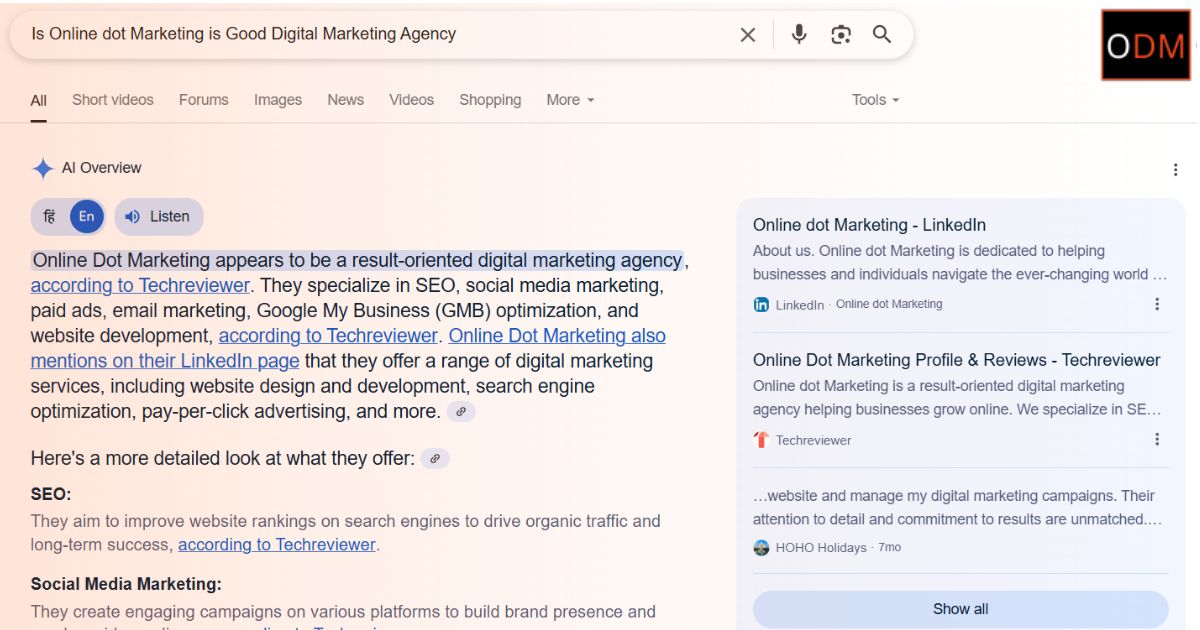Google AI Overview SEO is quickly becoming one of the most competitive areas for marketers, SEO professionals & content creators. If you’re trying to understand how to rank in AI Overviews, you’re not alone. With the rollout of AI-generated answers in Google Search results, the rules of visibility have changed. In this blog our team help you understand the shift, implement effective SEO strategies for Google AI Overview, and optimize your marketing content to be featured in these new formats.
Online dot Marketing has studied the changes, tested results, and compiled this detailed blog for those looking to master Google AI Overview SEO. Let’s break it down step by step so you can take real action that moves your content to the top.
What is Google AI Overview SEO?
Google AI Overview SEO refers to the process of optimizing your website content so it appears in Google’s AI-generated search summaries. These summaries show at the top of search results and pull in content from multiple sources to give users a complete, AI-generated answer.
If you’re serious about increasing visibility, traffic & authority, then you must include Google AI Overview SEO in your strategy and it’s different from traditional SEO and requires a new approach.
Why Google AI Overviews Matter for Marketers
Before diving into how to rank in AI Overviews, it’s important to understand why they matter so much in modern SEO strategies. Google AI Overviews are designed to summarize high-quality, reliable content across the web and present it right at the top of search results. These summaries improve user experience by saving time and delivering direct answers and if your content appears here, it means you’re viewed as a trusted voice in your field. For marketers, this placement results in a big visibility & engagement win. Ignoring this feature could cost your brand valuable traffic & authority in competitive spaces.
Here’s why AI Overviews are essential:
- They are displayed above traditional search result listings
- Brands featured see a 2x+ increase in click-through rates
- Summaries pull from authoritative sources across industries
- Results are formatted for voice search & mobile devices
- They increase trust by showing diverse, expert-backed insights
How to Rank in AI Overviews: Core Guidelines
To rank in Google AI Overviews, you need to rethink how you structure and present your content online. Traditional SEO alone won’t cut it anymore. Instead, content must be clear, question-focused, structured, and filled with data-backed insights. Google’s AI looks for content that answers questions directly, offers digestible formats like bullet points, and highlights the author’s real-world expertise and adding visual cues, structured data, and schema not only helps AI understand your content but also increases its trust factor. Your authority, clarity, and formatting now play equal roles in determining your visibility.
Follow these 5 methods to rank effectively:
- Write around question-based content such as “what is…”, “how to…”, or “why does…” to align with query patterns.
- Add schema and structured data for every article, especially for FAQs, How-To’s & about pages.
- Use bullet points and short summaries to make your content AI-digestible and user-friendly.
- Support your content with accurate facts, statistics & insights from industry experience.
- Include author details, professional credentials & E-E-A-T signals through schema markup and visible bios.
Google AI Search Ranking Tips You Should Apply Now
Search intent is the most important part of ranking in AI Overviews, and these techniques help you match it better. Online dot Marketing team recommends using these Google AI search ranking tips to boost your chances:
- Write niche-focused content targeting a specific search query with in-depth answers & practical takeaways relevant to your audience.
- Structure your blog posts using descriptive H2 and H3 headings that match how users search questions in your niche.
- Insert anchor links within long articles to make navigation easier for readers and AI systems indexing the content.
- Include glossaries, case studies & relevant definitions that provide context and value to informational pages.
- Use plain, natural English and break down complex concepts with short examples for better readability.
- Maintain consistency in tone, sentence length & formatting to help AI parse your content without confusion.
- Add schema markup on FAQs, articles, authorship & organization to signal page structure to Google AI.
- Regularly update content with new statistics, expert opinions & factual corrections to reflect industry changes.
- Include internal links pointing to supporting content on your site that extends or complements the current page.
- Write answers directly under commonly searched questions using bullet points or short lists to improve scannability.
Google AI Overview Marketing Strategy for Brands
Developing a Google AI Overview marketing strategy means building content that stands out from a data perspective. We customizes SEO strategies for Google AI Overview so you don’t get left out of high-intent traffic.
Steps to follow:
- Identify high-intent, long-tail keywords with informational value
- Create topic clusters & link them internally
- Add trust signals (testimonials, case studies, client quotes)
- Optimize content layout for AI summarization (tables, bold headers, lists)
- Audit your site’s authority with E-E-A-T metrics
Content Optimization for Google AI Overviews
Content optimization for Google AI Overviews requires a more thoughtful and structured approach to writing. Each section of your content should focus on answering user-intent queries clearly and quickly because Google’s AI prioritizes clean layouts, easy-to-read language, and sections that deliver direct answers. That means you must think about formatting, sentence length, paragraph structure, and use of supportive data or visuals. Instead of stuffing keywords, write like you’re talking to someone who asked a question because that’s exactly what the AI is trying to solve. Content optimization for Google AI Overviews is not just about visibility, but trust, clarity & accuracy.
Apply these 5 optimization actions:
- Begin every main section with a short answer that clearly addresses the reader’s likely question.
- Include relevant stats, real-life data, and direct examples to strengthen the factual value of your content.
- Organize complex explanations into clear, numbered steps or short bulleted breakdowns.
- Use high-quality visuals and always describe them with keyword-rich alt text and filenames.
- Interlink to similar blogs, FAQs, and service pages to create depth and authority around your core topic.
SEO Strategies for Google AI Overview: Technical Setup
Your website’s technical setup plays a major role in how Google’s AI interprets and ranks your content. Technical SEO is not just about fixing backend errors, it’s about building a clean, efficient, and crawlable structure that Google can easily process. For Google AI Overview SEO, your site must deliver both speed and accuracy. If your foundation is weak, even the best content may not make it to AI-generated summaries. Mobile-friendliness, security protocols, and markup language all affect how search engines perceive and showcase your site.
Here are 5 technical actions to take:
- Reduce page load time to under 2.5 seconds using compression, CDN & image optimization.
- Implement schema.org markup including Article, FAQ, How To, and Author to signal content type.
- Make sure your website is fully responsive and passes mobile usability standards.
- Install an SSL certificate, resolve any HTTPS-related warnings, and maintain secure access.
- Use tools like Google Search Console to identify crawl errors, fix broken links & update sitemaps regularly.
On-Page Google AI Overview SEO Checklist
Follow this consistently and your ranking chances go up and use this checklist from Online dot Marketing to fine-tune your page:
- Title tag includes long-tail query
- H1, H2, H3 structure is logical
- Meta description clearly summarizes content
- First 100 words answer the search query
- Bullet points used for breakdowns
- Facts, stats, dates included
- Schema markup validated
How to Rank in AI Overviews for Different Content Types
Each type has its own version of Google AI Overview SEO. Different formats require different techniques. Here’s how to rank in AI Overviews for blogs, service pages & guides:
- Blogs – Include a TL;DR summary with bullet points
- Service Pages – Add use cases, FAQs & pricing breakdowns
- Guides – Use step-by-step formatting with bold headers
Google AI Overview Marketing Strategy for Local Businesses
Online dot Marketing builds hyper-local pages that rank for both traditional SEO & AI Overviews. If you’re running a local business, here’s how to use Google AI Overview marketing strategy:
- Include city/area names in H2s & content
- Use Google Business Profile schema
- Add customer reviews & experience quotes
- Answer local queries in your content
- Mention service areas clearly
Google AI Search Ranking Tips for Faster Results
Here are some practical Google AI search ranking tips you can implement now:
- Rework your top-performing pages by adding well-written summary sections that clearly answer intent-based questions using straightforward language and supporting examples or bullet points.
- Add FAQ sections to the bottom of each blog, product, or service page, using schema to structure them and increase their chances of being selected in AI Overviews.
- Highlight important information using bold and underlined formatting to guide both human readers and Google’s AI toward the key takeaways of your content.
- Update your core content every 3–6 months by refreshing facts, replacing outdated links, and aligning with the most recent industry practices and ranking shifts.
- Always cite statistics, research, or official guidelines using links to high-authority websites, which reinforces trust and contributes positively to Google’s E-E-A-T assessment criteria.
Case Study: How Online dot Marketing Ranked in Google AI Overviews
One of our clients in the SaaS space wanted to improve their organic visibility. We redesigned their blog layout, added question-answer sections, improved schema markup, and restructured H2-H3 flow. Within 30 days, 3 of their blogs were featured in AI Overviews for core queries. We continue testing SEO strategies for Google AI Overview across industries.
Final Tips: Content Optimization for Google AI Overviews
This is how you meet Google’s content quality expectations. As a quick refresher, here’s how to approach content optimization for Google AI Overviews:
- Lead with value in first 100 words
- Use natural language with real-world examples
- Insert expert opinions or author bios
- Format answers for copy/paste usability
- Keep paragraphs under 100 words
- Embed data tables & charts when relevant
- Update content with new info regularly
Ranking in Google’s AI Overviews isn’t about tricking algorithms it’s about providing real answers in the clearest format. Google AI Overview SEO is your gateway to higher CTR, more impressions, and stronger brand authority. With the right SEO strategies for Google AI Overview, you’ll be visible in the most powerful area of search results. Online dot Marketing builds a Google AI Overview marketing strategy tailored for your business so you can compete smartly, not just loudly. Start optimizing today and let your content get the spotlight it deserves.





